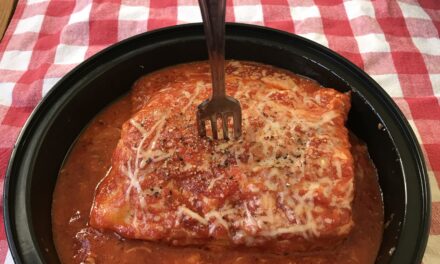by Paula Marcoux.

Garlic mustard (Alliaria petiolata) a pernicious invasive here in SEMA.
DEVOUR THE ENEMY: Garlic Mustard
Okay, so we’ll never entirely win the war against rampant honeysuckle, bittersweet, and burning bush, but, in a very good argument for picking our battles, we can beat out at least one invasive plant, and to the victor goes a damn good stir-fry. One of our more pernicious invasives here in southeastern Massachusetts (not to mention most of North America) just happens to be a delicious vegetable.
Garlic mustard (Alliaria petiolata) is easy to identify (see photo – smells pungently garlicky-mustardy), quick to harvest, keeps pretty well in the fridge, and cooks up quite nicely. Once you know it, you’ll see it everywhere–by the drive-up window at the bank, next to the liquor store, around the neighbor’s mailbox. Late spring is the best time to harvest, when it is young and tender and just flowering (and before it goes to seed and runs further amuck).
Virtually the entire above-ground portion of the plant can be eaten early on; later in the season, you may want to discard any woody stalks and keep to the tender tops and leaves. (If there are small and stunty plants you do not want for food, you are doing well to uproot them anyway; garlic mustard has a way of completely taking over and driving out all other vegetable life. But don’t let those innocent-looking white flowers wilt your resolve. This operator is known in Pennsylvania as a “BioBully” and in Washington state as a “Class A Noxious Weed”—chilling.
IDENTIFICATION
So, here’s a link to acres of info on the stuff, including more hints for identification: http://www.invasivespeciesinfo.gov/plants/garlicmustard.shtml
Wild Cohasset has a ‘Weed Fest’ every year to encourage volunteers to gather and pull the invasive. Here is their helpful video on identifying and pulling garlic mustard plants.
We like to think of it as (free!) broccoli rabe—quickly blanch it and give at an Italian treatment (tossed with garlic and cubes of parboiled potato fried in olive oil, maybe a spicy grilled sausage). Or use in a frittata, soup, or pasta dish.
Or try this quick and delicious adaptation from Authentic Vietnamese Cooking: Food from a Family Table, by Corinne Trang (Simon & Schuster, 1999). The author uses this treatment on a variety of vegetables, and we find it a great fit for garlic mustard, too, served with steamed jasmine rice and something tasty from the grill.
“Class A” Stir-fried Garlic Mustard
- 1 large bunch (1 to 2 pounds) Garlic Mustard, rinsed, woody stems discarded
- salt
- 1½ tablespoons vegetable oil
- 1 large clove garlic, minced
- 1 tablespoon fish sauce
- freshly ground black pepper
Bring a large pot of salted water to the boil, as if you were planning to make spaghetti. Drop in the greens for 45 seconds. Remove and drain. Put on a cutting board and run a knife across a few times, reducing to bite-size pieces.
Heat the oil in a wok over high heat. Stir-fry the garlic until fragrant and golden brown. Immediately add the greens (watch out for spattering), followed by the fish sauce and copious black pepper. Stir-fry a few minutes until tender. Serve hot and let it be a warning to the rest of them.
Paula Marcoux is a Plymouth-based food historian and the author of Cooking with Fire.






